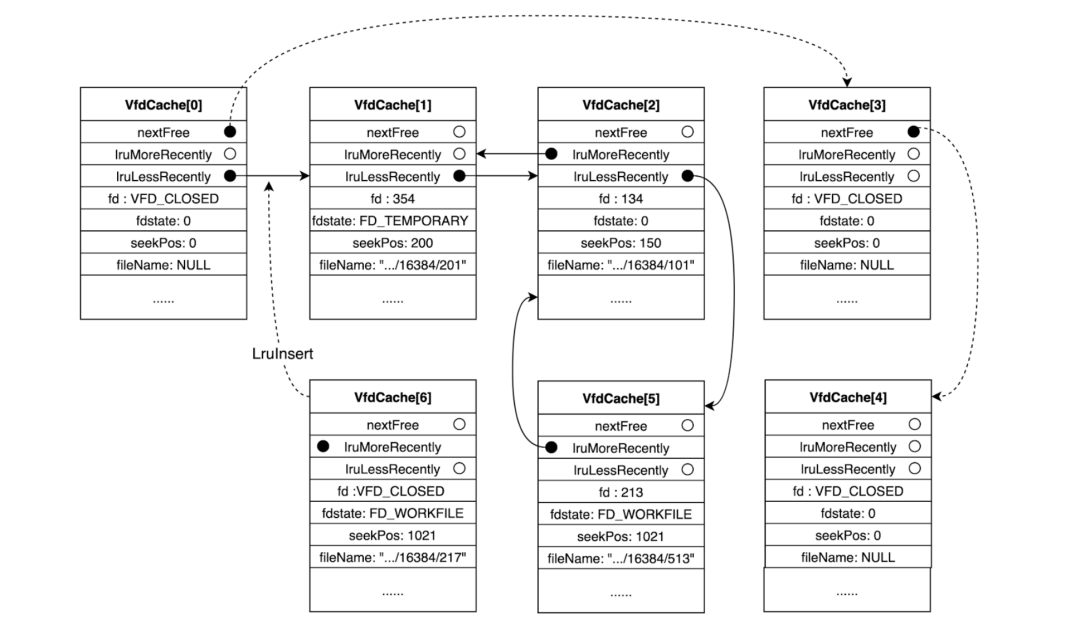Postgres 源码学习 2—Postgres 的 VFD 机制
Postgres 源码学习 2—Postgres 的 VFD 机制

roseduan
发布于 2024-04-19 11:10:42
发布于 2024-04-19 11:10:42
操作系统中的文件
数据库的本质其实就是用来存储数据的,所以免不了和文件系统、存储进行交互,万丈高楼平地起,存储一般是一个数据库的最底层,Postgres 在存储的文件管理方面也有很多的设计与抽象。
在操作系统层面,提供了一些文件操作相关的系统调用(fopen、fclose、fsync 等),我们作为上层使用者,可以直接通过 C 语言库进行调用即可(Postgres 使用 C 语言编写)。
具体和文件系统的交互我们并不关心,操作系统打开文件之后,会在进程的控制块中维护一些打开文件的相关信息,并返回一个文件描述符,后续我们与文件的交互都通过文件描述符进行。
操作系统能够打开多少文件,是有限制的,一个是系统级限制,指的是在内核中可以打开多少文件,可以通过命令 sysctl fs.file-max 查看。另一个是用户级限制,为了不让某个进程打开太多的文件,进而消耗所有的资源,对单个进程能打开文件也有限制,可以通过 ulimit -n 命令查看。
Postgres 的 VFD 作用
Postgres 数据库在运行的过程当中,可能会打开非常多的文件,比如数据表对应的文件,元数据表文件,以及一些在 SQL 运行时打开的临时文件,例如排序、哈希表所需的文件。
所以有非常大的概率超过单个进程打开文件数量的限制,为了解决这个问题,Postgres 设计了 VFD(虚拟文件描述符)机制,主要是将实际的操作系统文件描述符维护到一个 LRU 缓存中,通过切换打开的方式,规避了进程打开文件数量的限制。
如果一个进程打开的文件数目达到了限制,则暂时关闭最久未使用的文件,保存其状态,待下次重新打开。
VFD 的基本工作方式
Postgres 主要通过一个进程私有的数组来维护 VFD,名为 VfdCache。
/*
* Virtual File Descriptor array pointer and size. This grows as
* needed. 'File' values are indexes into this array.
* Note that VfdCache[0] is not a usable VFD, just a list header.
*/
static Vfd *VfdCache;
VfdCache 数组的第一个元素不存储任何数据,仅作为头部使用,下面是 vfdCache 的初始化逻辑,会在 backend 进程启动的时候调用,大致的逻辑就是为 VfdCache 数组分配内存。
/*
* InitFileAccess --- initialize this module during backend startup
*
* This is called during either normal or standalone backend start.
* It is *not* called in the postmaster.
*
* Note that this does not initialize temporary file access, that is
* separately initialized via InitTemporaryFileAccess().
*/
void
InitFileAccess(void)
{
Assert(SizeVfdCache == 0); /* call me only once */
/* initialize cache header entry */
VfdCache = (Vfd *) malloc(sizeof(Vfd));
if (VfdCache == NULL)
ereport(FATAL,
(errcode(ERRCODE_OUT_OF_MEMORY),
errmsg("out of memory")));
MemSet((char *) &(VfdCache[0]), 0, sizeof(Vfd));
VfdCache->fd = VFD_CLOSED;
SizeVfdCache = 1;
}
如果需要打开一个文件,那么会首先在 VfdCache 数组中查找空闲的虚拟文件描述符,主要是通过 nextFree 指针进行查找,如果当前没有空闲的 vfd 了,那么会启动扩容机制,初始情况下,VfdCache size 是 32,每次扩容为原来的 2 倍。
Vfd 扩容和分配的逻辑都在方法 AllocateVfd 中。
static File
AllocateVfd(void)
{
Index i;
File file;
DO_DB(elog(LOG, "AllocateVfd. Size %zu", SizeVfdCache));
Assert(SizeVfdCache > 0); /* InitFileAccess not called? */
if (VfdCache[0].nextFree == 0)
{
/*
* The free list is empty so it is time to increase the size of the
* array. We choose to double it each time this happens. However,
* there's not much point in starting *real* small.
*/
Size newCacheSize = SizeVfdCache * 2;
Vfd *newVfdCache;
if (newCacheSize < 32)
newCacheSize = 32;
/*
* Be careful not to clobber VfdCache ptr if realloc fails.
*/
newVfdCache = (Vfd *) realloc(VfdCache, sizeof(Vfd) * newCacheSize);
if (newVfdCache == NULL)
ereport(ERROR,
(errcode(ERRCODE_OUT_OF_MEMORY),
errmsg("out of memory")));
VfdCache = newVfdCache;
/*
* Initialize the new entries and link them into the free list.
*/
for (i = SizeVfdCache; i < newCacheSize; i++)
{
MemSet((char *) &(VfdCache[i]), 0, sizeof(Vfd));
VfdCache[i].nextFree = i + 1;
VfdCache[i].fd = VFD_CLOSED;
}
VfdCache[newCacheSize - 1].nextFree = 0;
VfdCache[0].nextFree = SizeVfdCache;
/*
* Record the new size
*/
SizeVfdCache = newCacheSize;
}
file = VfdCache[0].nextFree;
VfdCache[0].nextFree = VfdCache[file].nextFree;
return file;
}
拿到虚拟文件描述符之后,会调用 C 库函数 open 实际去打开文件,并且将一些文件状态维护到 Vfd 结构体中,这个结构体主要存储的是虚拟文件描述符的一些信息,也就是存储到 VfdCache 数组中的结构。
typedef struct vfd
{
int fd; /* current FD, or VFD_CLOSED if none */
unsigned short fdstate; /* bitflags for VFD's state */
ResourceOwner resowner; /* owner, for automatic cleanup */
File nextFree; /* link to next free VFD, if in freelist */
File lruMoreRecently; /* doubly linked recency-of-use list */
File lruLessRecently;
off_t fileSize; /* current size of file (0 if not temporary) */
char *fileName; /* name of file, or NULL for unused VFD */
/* NB: fileName is malloc'd, and must be free'd when closing the VFD */
int fileFlags; /* open(2) flags for (re)opening the file */
mode_t fileMode; /* mode to pass to open(2) */
} Vfd;
Vfd 结构体中,主要通过 nextFree、lruMoreRecently、lruLessRecently 指针将 vfd 维护到不同的队列里面。
每次新打开一个文件,都会将该 vfd 通过 lruMoreRecently 和 lruLessRecently 指针,维护这个双向链表,每次关闭一个 VfdCache 中的文件,都会将其从链表中删除。
每次查找空闲的 VfdCache 的时候,都会通过 nextFree 链表进行查找。

img
以访问文件为例,首先会判断文件是否打开,如果没有打开的话,则打开文件并且将其放到最近使用的链表中。
主要的逻辑在函数 LruInsert 中,在实际打开文件之前,会尝试关闭最久未使用的文件。
然后会通过系统调用打开文件,并且获取到实际的文件描述符(fd),将其保存到 vfdP 结构中。
static int
LruInsert(File file)
{
Vfd *vfdP;
Assert(file != 0);
DO_DB(elog(LOG, "LruInsert %d (%s)",
file, VfdCache[file].fileName));
vfdP = &VfdCache[file];
if (FileIsNotOpen(file))
{
/* Close excess kernel FDs. */
ReleaseLruFiles();
/*
* The open could still fail for lack of file descriptors, eg due to
* overall system file table being full. So, be prepared to release
* another FD if necessary...
*/
vfdP->fd = BasicOpenFilePerm(vfdP->fileName, vfdP->fileFlags,
vfdP->fileMode);
if (vfdP->fd < 0)
{
DO_DB(elog(LOG, "re-open failed: %m"));
return -1;
}
else
{
++nfile;
}
}
/*
* put it at the head of the Lru ring
*/
Insert(file);
return 0;
}
如果文件已经是打开状态,那么会先从链表中删除,然后将其插入到最近使用的链表中。将 Vfd 加入到链表中,代码如下,可以看到主要是通过维护 lruMoreRecently 和 lruLessRecently 这两个指针,将当前 vfd 加入到链表的头部。
static void
Insert(File file)
{
Vfd *vfdP;
Assert(file != 0);
DO_DB(elog(LOG, "Insert %d (%s)",
file, VfdCache[file].fileName));
DO_DB(_dump_lru());
vfdP = &VfdCache[file];
vfdP->lruMoreRecently = 0;
vfdP->lruLessRecently = VfdCache[0].lruLessRecently;
VfdCache[0].lruLessRecently = file;
VfdCache[vfdP->lruLessRecently].lruMoreRecently = file;
DO_DB(_dump_lru());
}
而 Delete 方法则描述的是将一个 vfd 从链表中删除。
static void
Delete(File file)
{
Vfd *vfdP;
Assert(file != 0);
DO_DB(elog(LOG, "Delete %d (%s)",
file, VfdCache[file].fileName));
DO_DB(_dump_lru());
vfdP = &VfdCache[file];
VfdCache[vfdP->lruLessRecently].lruMoreRecently = vfdP->lruMoreRecently;
VfdCache[vfdP->lruMoreRecently].lruLessRecently = vfdP->lruLessRecently;
DO_DB(_dump_lru());
}
小结
Postgres 中的 VFD,即虚拟文件描述符,主要是为了能够规避操作系统中最大打开文件数的限制,采用切换打开的方式,维护了一个链表,将最近打开的文件维护到链表头部,最久未使用的文件放置到链表尾部。
访问文件的时候,会从 VfdCache 数组中查找空闲的虚拟文件描述符,如果找到的话,则直接使用,否则分配新的 VfdCache 空间。
在打开文件的时候,会尝试关闭最久未使用的文件,将位置留给最新打开的文件。
通过这种方式,Postgres 可以打开远超过系统和进程限制的文件数量,是一个非常精妙的设计。
本文参与 腾讯云自媒体同步曝光计划,分享自微信公众号。
原始发表:2024-04-18,如有侵权请联系 cloudcommunity@tencent.com 删除
本文分享自 roseduan写字的地方 微信公众号,前往查看
如有侵权,请联系 cloudcommunity@tencent.com 删除。
本文参与 腾讯云自媒体同步曝光计划 ,欢迎热爱写作的你一起参与!
评论
登录后参与评论
推荐阅读
目录

